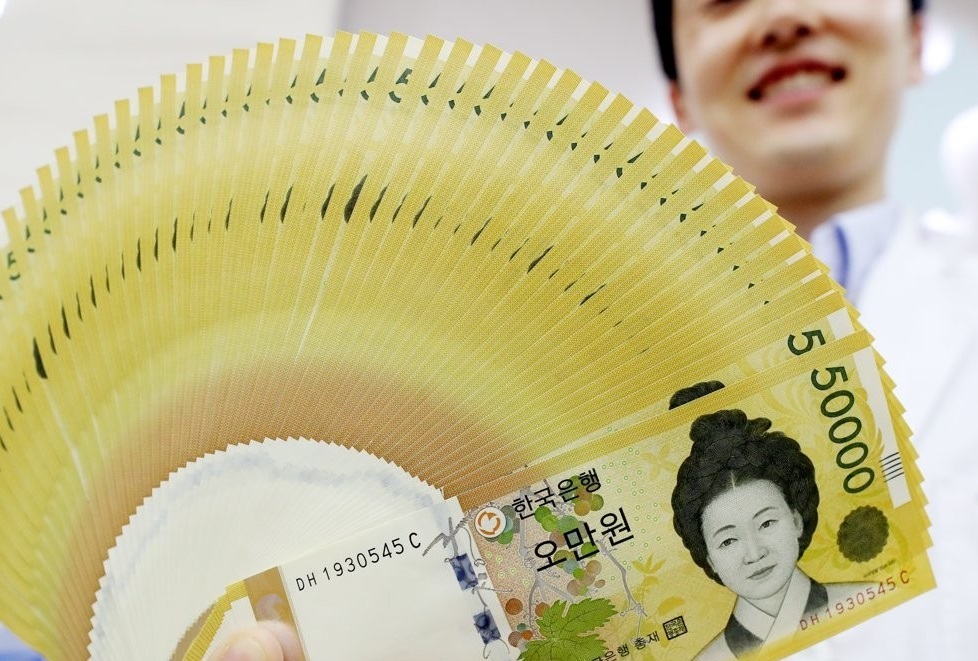Percentage of 50,000 won notes returned to central bank falls to all-time low
By Jung Min-kyungPublished : Nov. 30, 2020 - 15:17

South Korea’s central bank said Monday that the percentage of 50,000 won ($45.26) notes returned to the bank plummeted to a record low due to sentiment surrounding the COVID-19 pandemic.
The return rate fell to 25.4 percent for the first 10 months of this year, the lowest level since the notes began circulating in June 2009 and 39.4 percentage points lower than for the same period last year, the Bank of Korea said in a report.
The BOK issued 21.9 trillion won worth of 50,000 won notes in the January-October period, but only 5.6 trillion won of that was returned to the bank, spurring concerns.
It previously expressed concerns about the possibility of the notes flowing into the underground economy, as it identified a shortage of 50,000 won notes in the money supply.
But this time the key reasons behind the shortage were a decline in face-to-face cash transactions in retail stores, restaurants and accommodation services and people deciding to save cash instead of spending it in times of uncertainty, the bank said.
“Unlike past financial crises, where manufacturing and construction were hit the hardest, COVID-19 has dealt a blow to accommodation, restaurants and leisure services, which contracted due to lack of face-to-face interactions,” the BOK said.
“Through discussions with commercial banks we have found out that 50,000 won deposits via automatic teller machines near tourist spots including duty free shops, casinos and currency exchange outlets have noticeably declined,” it added.
Koreans are also saving cash on risks stemming from market volatility and low interest rates. The BOK has maintained a record-low interest rate of 0.5 percent for months now, to minimize economic fallout from the pandemic.
In other economies, the BOK said, demand for higher-denomination banknotes such as $100 bills has increased, while return rates have declined amid the pandemic, mirroring Korea’s situation. But their return rates are much higher compared with that for 50,000 won notes, it added.
“Compared with high notes of other key economies, the return rate of 50,000 won is noticeably low, because in terms of the note’s life cycle, it is still in its growth stage regarding supply (because it was created relatively recently),” it explained.
“The self-employed also take up a lot of Korea’s economy compared with other key economies, so we believe it affected the return heavily during a time of financial uncertainties.”
By Jung Min-kyung (mkjung@heraldcorp.com)
The return rate fell to 25.4 percent for the first 10 months of this year, the lowest level since the notes began circulating in June 2009 and 39.4 percentage points lower than for the same period last year, the Bank of Korea said in a report.
The BOK issued 21.9 trillion won worth of 50,000 won notes in the January-October period, but only 5.6 trillion won of that was returned to the bank, spurring concerns.
It previously expressed concerns about the possibility of the notes flowing into the underground economy, as it identified a shortage of 50,000 won notes in the money supply.
But this time the key reasons behind the shortage were a decline in face-to-face cash transactions in retail stores, restaurants and accommodation services and people deciding to save cash instead of spending it in times of uncertainty, the bank said.
“Unlike past financial crises, where manufacturing and construction were hit the hardest, COVID-19 has dealt a blow to accommodation, restaurants and leisure services, which contracted due to lack of face-to-face interactions,” the BOK said.
“Through discussions with commercial banks we have found out that 50,000 won deposits via automatic teller machines near tourist spots including duty free shops, casinos and currency exchange outlets have noticeably declined,” it added.
Koreans are also saving cash on risks stemming from market volatility and low interest rates. The BOK has maintained a record-low interest rate of 0.5 percent for months now, to minimize economic fallout from the pandemic.
In other economies, the BOK said, demand for higher-denomination banknotes such as $100 bills has increased, while return rates have declined amid the pandemic, mirroring Korea’s situation. But their return rates are much higher compared with that for 50,000 won notes, it added.
“Compared with high notes of other key economies, the return rate of 50,000 won is noticeably low, because in terms of the note’s life cycle, it is still in its growth stage regarding supply (because it was created relatively recently),” it explained.
“The self-employed also take up a lot of Korea’s economy compared with other key economies, so we believe it affected the return heavily during a time of financial uncertainties.”
By Jung Min-kyung (mkjung@heraldcorp.com)








![[KH Explains] How should Korea adjust its trade defenses against Chinese EVs?](http://res.heraldm.com/phpwas/restmb_idxmake.php?idx=644&simg=/content/image/2024/04/15/20240415050562_0.jpg&u=20240415144419)











![[Today’s K-pop] Stray Kids to return soon: report](http://res.heraldm.com/phpwas/restmb_idxmake.php?idx=642&simg=/content/image/2024/04/16/20240416050713_0.jpg&u=)